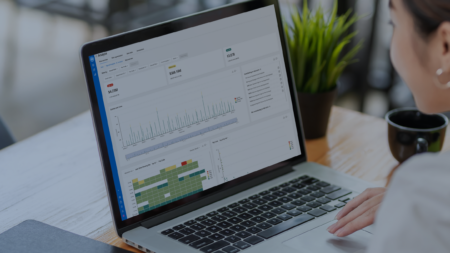The Role of Data Analytics in Internal Audit
Internal audit is no longer just about compliance and risk mitigation—it has become a strategic function that safeguards business integrity and enhances operational efficiency. Today’s internal auditors are expected to manage increasingly complex financial landscapes, address rising regulatory pressures, and provide continuous risk insights.
Traditional audit approaches—rooted in sample testing and retrospective analysis—are no longer sufficient to keep pace with today’s data-driven business environments. To bridge this gap, AI-powered data analytics is reshaping internal audit, allowing auditors to transition from reactive oversight to proactive risk intelligence by uncovering hidden anomalies, improving audit efficiency, and strengthening internal controls.
The Challenges of Traditional Internal Audits
Legacy internal audit methodologies rely on sample-based testing, periodic reviews, and manual processes, leading to several challenges:
- Limited Risk Coverage — Reviewing only a fraction of transactions leaves blind spots where fraud, errors, or policy violations can remain undetected.
- Delayed Risk Detection — Audits often work with historical data, making it difficult to identify immediate risks or anomalies.
- High Operational Costs — Manual audit processes require significant time and resources, limiting the capacity for strategic risk assessment.
- Lack of Actionable Insights — Compliance-driven audits often fail to deliver strategic recommendations that drive business improvement.
5 Key Benefits of Data Analytics in Internal Audit
1. Improved Risk Coverage with 100% Data Analysis
Traditional audits rely on limited sample sets, leaving significant gaps. AI-powered analytics assess 100% of transactions in financial systems, ensuring comprehensive risk assessment and improved accuracy.
- Identify irregular transactions across general ledgers, subledgers, and financial reporting systems.
- Detect fraud indicators such as duplicate payments, unauthorized approvals, or policy breaches.
- Enhance risk assessment by surfacing patterns that would typically go unnoticed in manual reviews.
2. Enhanced Compliance and Internal Controls
Regulatory scrutiny continues to grow, making compliance management a top priority for internal audit teams. AI-powered analytics ensure that organizations maintain continuous compliance while streamlining audit workflows.
- Strengthen SOX compliance by identifying control weaknesses and improving financial oversight.
- Automate audit sampling and transaction testing to reduce human bias and increase audit efficiency.
- Generate audit-ready reports that provide clear documentation for regulatory submissions and internal stakeholders.
3. Proactive Fraud Detection and Anomaly Identification
Fraudulent activities and financial misstatements often go undetected until after audits are completed. AI-powered analytics flag suspicious activities in real-time, preventing costly errors and fraud before they escalate.
- Unsupervised machine learning uncovers unknown fraud risks and process failures.
- Continuous transaction monitoring alerts auditors to high-risk activities as they occur.
- Predictive analytics anticipate potential compliance breaches, allowing for proactive remediation.
4. Increased Audit Efficiency and Automation
Audit teams often operate with limited resources, balancing multiple audits while managing regulatory demands. AI-driven automation eliminates repetitive tasks, enabling auditors to focus on high-value strategic activities.
- Reduce manual reconciliation workloads with automated anomaly detection.
- Streamline audit documentation through AI-powered reporting and visualization tools.
- Accelerate audit cycles by integrating AI-driven insights into enterprise risk management frameworks.
5. Clearer Reporting and Actionable Insights
AI-driven analytics provide interactive dashboards that transform complex financial data into clear, actionable insights. Internal auditors can present findings more effectively to stakeholders and leadership.
- Dynamic risk visualization enables executives to make data-driven decisions.
- Automated reporting improves transparency and accountability across financial operations.
- Cross-functional collaboration aligns audit insights with broader enterprise objectives.
Implementing Data Analytics in Internal Audit: A Step-by-Step Guide
1. Planning: Identifying Key Risk Areas & Data Sources
Internal auditors must first define audit objectives, identify high-risk areas, and determine which data sources will provide the most valuable insights.
2. Data Extraction: Ensuring Clean and Complete Data
Accessing and preparing data is often one of the biggest challenges in audit analytics. AI-powered platforms like MindBridge ensure accurate, structured, and continuous data extraction from various financial systems.
3. AI-Powered Analysis: Detecting Fraud, Inefficiencies, and Control Weaknesses
Machine learning models analyze transactions to uncover anomalies, policy violations, and emerging risks. AI eliminates false positives, ensuring auditors focus on real threats.
4. Reporting & Action: Delivering Audit-Ready Insights for Decision-Making
Automated dashboards provide a continuous view of financial health, enabling internal auditors to deliver insights that drive better financial decision-making.
Case Study: How Align Technologies Transformed Internal Audit with AI
Align Technologies, a leader in orthodontic innovation, adopted MindBridge AI to enhance its internal audit function. The results?
- 90% reduction in manual audit processes
- 100% transaction analysis, eliminating sample-based blind spots
- Continuous anomaly detection improved risk response times
“MindBridge enabled us to automate risk identification and focus on strategic audit insights. Our team now spends more time on high-value analysis instead of manual sampling.”
This transformation underscores how AI-powered data analytics can revolutionize internal audit workflows, making audits more efficient, data-driven, and risk-aware.
The Future of Internal Audit: AI-Powered Decision Intelligence
As businesses navigate increasing financial complexity, internal audit teams must evolve from compliance enforcers to strategic advisors who leverage AI-powered analytics to guide decision-making.
AI-driven audit analytics empower internal auditors to:
- Move from periodic audits to continuous assurance by embedding continuous monitoring.
- Enhance collaboration with CFOs and leadership to inform risk-based decisions.
- Enable dynamic risk assessment models that adapt to changing business environments.
Organizations that integrate AI-driven insights into their audit frameworks will improve risk management and unlock new opportunities for efficiency and strategic oversight.
Transform Your Internal Audit Strategy with MindBridge
MindBridge empowers internal audit teams with AI-driven risk intelligence, continuous monitoring, and automated anomaly detection. With our platform, auditors can:
- Reduce audit complexity
- Strengthen internal controls
- Improve compliance efficiency
- Identify financial risks before they escalate
Are you ready to modernize your internal audit function?
Book a demo today and discover how MindBridge AI-powered analytics can transform your audit strategy.



